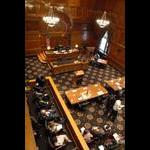I appreciate being invited to be the featured alum blogger for April. This being my first blog experience, I am going to ease in with an answer to the question of the month: What was your most useful or enjoyable extracurricular activity in law school?
Since I married a classmate following graduation, I don’t need to tell you how useful or enjoyable that was, except to report that I am still very happily married to Mark, also a member of the Class of 1978.
I have very fond memories of the potluck dinners shared by the women students of my class. We weren’t a huge number — 28 of the 130 graduating students. Remarkably, most of us would attend these ad hoc affairs every other month or so. Mothers would bring their babies. It allowed us to develop a bond that was pretty unique. Besides the wine and food, we shared outlines (I understand good outlines are still a hot commodity), strategies, complaints, fears, and hopes. It was, in fact, an informal collaboration that worked very well for me and I suspect many others as we struggled through those three tough years.
While women are no longer such a small group, I imagine these sorts of gatherings still occur among all the students in some manner. It was for me an enjoyable, healthy way to deal with the anxiety and stress of the law school experience. And at that time, with one-third of the first year students not making it to the second year, it was indeed stressful — perhaps more about that era of the law school later.

